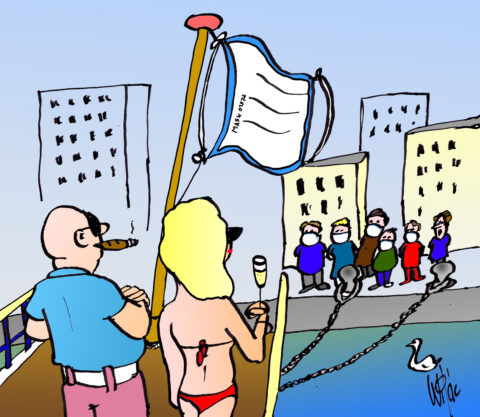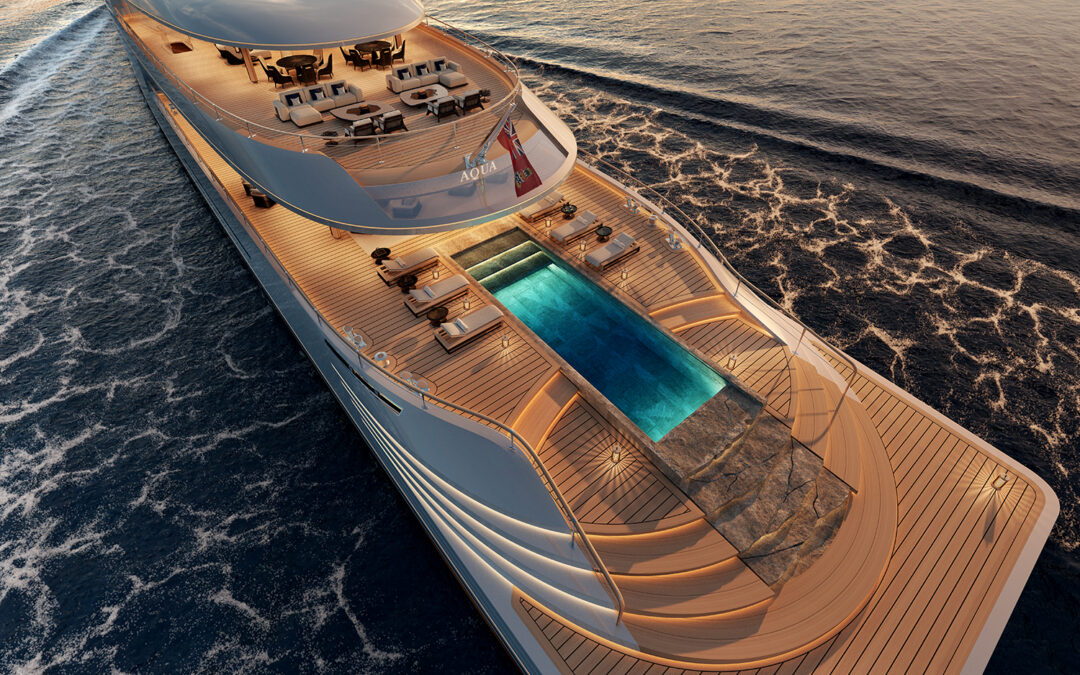While the world’s biggest cruise shipbuilders in especially Germany got into serious financial troubles and had to lay off thousands of workers and the whole cruise industry came to a total standstill, the Dutch specialists in the building of superyachts enjoyed a very good year last year. The number of orders they received in fact doubled.
In every issue of SWZ|Maritime, SWZ|Maritime’s editor-in-chief Antoon Oosting writes an opinion piece under the heading “Markets” about the maritime industry or a particular sector within it. In the September 2021 issue, he discusses the Dutch yacht building industry.
It is, to say the least, particularly noteworthy, striking and at the same time uplifting for the Dutch shipbuilding industry that the yacht industry is doing so well. In a recent podcast of Netherlands Maritime Technology (NMT), project director Roderick Gort of Dutch superyacht builder Oceanco from Alblasserdam confirmed that the near future prospects for his yard and its Dutch competitors like Feadship, Damen Yachting, Royal Huisman, Heesen and Moonen are just fine. ‘There is a healthy commercial market,’ Gort said.
The fact that at the end of 2020 the Dutch yards were building no less than thirteen superyachts on speculation, meaning they started construction without yet having a customer for it, is a clear sign of the confidence that the yards have in the future. Confidence that is based on excellent figures on new orders. From new orders worth € 1.067 billion in 2018 and € 1.012 billion in 2019, the newly received orders rose to a staggering € 2.150 billion last year. With this,the value of the total orderbook grew from € 4.078 billion in 2018 and € 4.021 billion in 2019 to a very healthy volume of € 5.380 billion last year. I bet there aren’t that many people who would have dared to predict this in January/February 2020, when the world turned into a deep crisis due to the Covid-19 pandemic.
A very uncertain market
In the podcast, Gort also told that at the beginning of 2020, the atmosphere was very uncertain. The yard’s management monitored the developments of the pandemic from day to day and decided to take measures at an early stage. The obligation to wear a face mask in the workplace was implemented and everyone who was not constantly needed at the offices in Alblasserdam and the recently acquired new facilities in Zwijndrecht had to work from home.
The workers that had to keep working on the yachts, including the personnel of suppliers, had to be tested every day. Oceanco has set up its own test site for this. ‘All this to be able to work safely… Our suppliers, too, realy appreciated this way of working. It has created a very safe working environment and allowed us to continue working in full,’ Gort explained. And there was enough work, as after the first uncertain months in spring, the first orders began dropping in.
Also read: The owners of superyachts built in the Netherlands revealed
Richest man in the world
A clear sign that despite the first panic about the economic consequences of the pandemic the superyacht business was not doing so badly at all, were the reports in May 2020 that the at that moment richest man in the world – e-commerce giant Amazon’s Jeff Bezos – had ordered a 127-metre three-mast yacht at Oceanco. This mega sailing yacht worth several hundreds of millions of euros will be accompanied by a smaller ship with a helicopter platform to provide the yacht with supplies. Whatever one might think about the superrich that always get richer, this is also a huge compliment to the Dutch superyacht industry and recognition of the unrivalled quality the Dutch yards can deliver.
Like Genie, the genie from Aladdin’s lamp, the Dutch yacht builders make the dreams of their clients come true. And like Oceanco’s project director Gort pointed out, the clients are dreaming of a unique and everbigger, longer yacht. So, the yachts are getting longer and more and more custom built. And about ten years ago, the Dutch yacht builders were especially strong in building yachts from thirty to sixty or seventy metres, but now they compete with the German yards that were always building the biggest yachts.
Moreover, in the category of less than 100 metres, the Dutch yards continue to be a strong competitor to the Germans and especially the Italian and Turkish yards.

A good year
Like Feadship, Damen Yachting, Oceanco, Royal Huisman, Heesen and Moonen all booked good results in 2020. According to the annual report of NMT, the size of the yachts delivered varied between 24 and 120 metres. The Netherlands is building ever larger yachts. In 2020, six yachts were sold that were eighty metres or larger (megayachts). In 2019, that was still only one. The orderbook of the Dutch yards currently contains fifteen yachts of eighty metres or larger.
NMT warns that the growing amount of work also has a downside. Several suppliers can’t process more orders as the workloads are greater than they can normally handle. NMT emphasizes the need for more intensive cooperation between yards and suppliers.
Due to the pandemic and travel restrictions imposed by authorities, a lot of shows were cancelled and even the selling process was hit. Royal Huisman and Moonen did manage to sell some ships online, however.
Travel restrictions
Those travel restrictions also hampered the construction of the yachts as clients, supervisors and superintendents that must monitor refits, and future crews, who had to be trained with their new ship, experienced difficulties with entering the Netherlands. Deliveries were not always easy to handle. But when NMT published its annual report in May this year, it could also be reported that this matter had successfully been solved in good cooperation with the responsible department and border control.
Travelling easily to and from the Netherlands is also a basic precondition for the refitting of yachts. Under the umbrella of NMT, the yacht building industry works together in the Holland Yachting Group to strengthen the interests of the Dutch yacht building industry. One of the opportunities the Holland Yachting Group has identified, is the growing need for refits. Super- and megayachts change ownership ever more often, or the owners want their ships modified and adjusted to the requirements of the future or to make the propulsion and energy systems of the ships more sustainable.
For still just a decade ago, clients often wanted their newbuilt superyacht to be able to sail fast. So, superyachts were often equipped with very powerful engines that used a lot of fuel. But sailing at high speed often goes at the cost of comfort with more noise and vibration. Yet, according to the project director of Oceanco, owners are also becoming aware that installing so much power often has no sense and nowadays there is more need for a more efficient power train that uses far less energy.
The Dutch are warming up to refits
‘Customers like to come back to the original builder of their yacht,’ Gort stated in the NMT podcast. ‘The original builder has the network of suppliers and can meet any requirements demanded by the customer at short notice. As a result, the barrier to sail their yacht to northwestern Europe is gone.’
With this in mind, Oceanco has taken over the former yard of offshore supplier Heerema in Zwijndrecht and Royal Huisman has opened a new site in Amsterdam. Royal Van Lent, which belongs to the Feadship group, has also opened a second yard, in addition to the one on Kaag island, in the Amsterdam port area. In the port of Rotterdam there are initiatives as well to do more with the refit of super- and megayachts.
While for many in the Netherlands the superyacht industry stays a rather unknown sector, the Dutch superyacht yards have an excellent reputation. Every year, new Dutch yachts are awarded important professional prizes. In 2020, Feadship won awards with three yachts at the World SuperYacht Awards. These were M/Y Pi (Motor yacht of the year, displacement motor yachts between 1500 GT and 1999 GT); M/Y Najiba (Displacement motor yachts between 500 GT and 999 GT); and M/Y Lady S (Displacement motor yachts between 2000 GT and 4999 GT). Another award went to Royal Huisman/Huisfit for the refit of S/Y Vagrant (category Re-built yachts).
Also read: Feadship wins big at World Superyacht Awards
The yacht as a corona bubble
For the success of the superyacht in a time that the world has suffered an enormous amount of casualties and a lot of people as well as the economy have to conform to annoying restrictions, Oceanco’s project director Gort has a statement as remarkable as it is simple. Super- and megayachts offer a private and safe area to pass your holidays, in easily controlled surroundings. The crew of a superyacht consists of up to fifteen or twenty people plus the guests that the owner chooses himself.
That is of course a number of people that is far more easily controlled and tested than those on a big cruise ship where the number of passengers and crew can be up to 7000 or 8000 (Oasis-class Royal Caribbean). ‘A superyacht is easy to control and to keep clean,’ according to Gort.
Picture (top): Superyacht Aqua’s aft deck features an innovative series of platforms cascading down towards the sea (courtesy of Sinot Yacht Architecture & Design, as published in SWZ|Maritime’s September yacht special).
SWZ|Maritime’s superyacht special
This article is part of SWZ|Maritime’s September superyacht special. Our special dives into the world of Dutch superyacht building and shows why shows why Dutch yacht builders are among the world’s best. Topics include electrification, an energy label for superyachts, innovative fenders, hydrofoil research and much more.
SWZ|Maritime is available to subscribers only. Not yet a subscriber? Please visit our subscriptions page.
Also read: SWZ|Maritime’s September 2021 issue: ‘Dutch superyachts are serious business’








